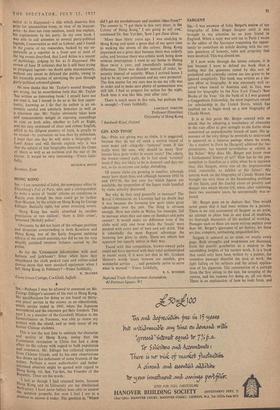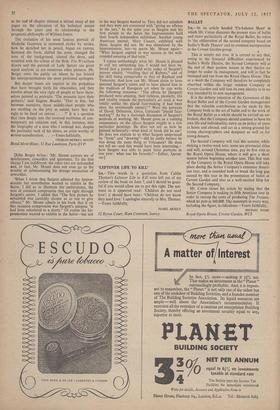SARGENT
SIR,—I was unaware of John Berger's review of my biography of John Singer Sargent until it was brought to my attention by an irate friend in England. When a copy was sent me in Paris I wrote to the editor of the Spectator requesting the oppor- tunity to contribute an article dealing with the cer- tain questions of honesty, taste and propriety that were involved. This was denied me.
If I now write through the letters column, it is less because I want to defend my book than a feeling that the questions raised by this sort of prejudiced and cowardly review are too grave to be ignored completely. The book was written as a sin- cere effort at biography. It was extremely well re- ceived when issued in America and, in fact, was listed for biography by the New York Times's 'Best Books of the Year.' On the basis of it I was granted a Guggenheim Fellowship, the most important award for scholarship in the United States, which has enabled me to begin work on a new biography of Claude Monet.
It is at this point Mr. Berger entered with an attack that by adopting a vocabulary of obscenity in the vain effort to give strength to his feeble ideas committed an unpardonable breach of taste. His ig- norance of the very things he pretends to understand is apparent in a fatuous passage where he states, 'As a student in Paris he [Sargent] admired the Im- pressionists, but wanted nevertheless to exhibit at the Salon.' Why does Mr. Berger not know even a fundamental history of art? How has he the pre- sumption to function as a critic when he is unaware that, like Sargent, every one of the Impressionists tried, repeatedly, to exhibit at the Salon? My current work on the biography of Claude Monet has brought me very close to the heartrending problem of the Salon, and the fearful abyss of poverty and despair into which Monet fell, when, after exhibiting there two successive years, he unexpectedly was re- jected.
Mr. Berger goes on to deplore that 'One would never guess that it had been written by a painter. There is no real assessment of Sargent as an artist, no attempt to place him in any kind of tradition, no thorough discussion of his method of working.' Passages such as these are more serious matters even than Mr. Berger's ignorance of art history, for these are lies; complete, unblushing, unqualified lies.
Sargent is assessed as an artist on nearly every page. Both strengths and weaknesses are discussed, from his puerile gaucheries as a student to the astonishing heights of his mature work. It is a book that could only have been written by a painter, for countless passages describe the man at work, the light falling on his subjects and the actual applica- tion of his pigments. The construction of a portrait from the first sitting to the last, his scraping of the canvas, and his reasons for doing so, all are there. There is an explanation of how he built form, and at the end of chapter thirteen a virtual essay of ten pages on the alteration of his technical means through the years and its relationship to the pragmatic philosophy of William James.
The, evolution of his most famous portrait of Madame Gautreau is recounted stroke by stroke; how he sketched her in pencil, began on canvas, flattened the form, shifted the arms, changed the tone of the background, altered the dress, and troubled with the colour of the flesh. The Wyndham Sisters and the portrait of Lady Speyer are given equal analysis, as are numerous other pictures. Mr. Berger owes the public on whom he has foisted his misrepresentations the most profound apologies.
But deeper issues are implicit in the prejudices that have brought forth his obscenities, and they revolve about the very right of people to have them- selves painted as portraits. The peasants have their painters,' said Eugene Boudin. 'That is fine, but between ourselves, those middle-class people who are strolling on the jetty at sunset, have they no right to be fixed on canvas . . . ?' It is a question that runs deeply into the reversed snobbism of con- temporary art criticism and, in this instance, into the biography of a man who I contend was, despite the particular rank of his sitters, an artist worthy of serious consideration. . . .—Yours faithfully,
CHARLES MERRILL MOUNT
Hotel Mont-Blanc, 51 Rue Lauriston, Paris-XY le [John Berger writes : 'Mr. Mount accuses me of tastelessness, cowardice and ignorance. To the first Charge I am indifferent; the other two are unfounded and, in fact, Mr. Mount does not even go to the trouble of substantiating his strange accusation of cowardice.
'When I wrote that Sargent admired the Impres- sionists but nevertheless wanted to exhibit in the Salon, I did so to illustrate the ambivalence, the vein of constant compromise that ran right through Sargent's career. I added that "The first picture he submitted was carefully chosen so as not to give offence." Mr. Mount admits in his book that if on this occasion compromise was Sargent's purpose "it had been calculated to a nicety." Of course the Im- pressionists wanted to exhibit in the Salon—but not
in the way Sargent wanted to. They did not calculate and they were not concerned with "giving no offence to the jury." In the same year as Sargent sent his first picture to the Salon the Impressionists held their fourth independent exhibition. Another young American painter, Mary Cassatt, exhibited with them. Sargent did not. He was stimulated by the Impressionists, but—to quote Mr. Mount again— "What Sargent aspired to was success in the well- rounded meaning of that term."
'I repeat unblushingly what Mr. Mount is pleased to call my unblushing lies. I would not have be- lieved that a painter could write today of Sargent's intense vitality, "rivalling that of Rubens," and of his skill being comparable to that of Raphael and Tintoretto. And how can Mr. Mount claim to have assessed Sargent's talent and to have placed him in the tradition of European art when he can write the following nonsense : "The effects he [Sargent] produced were amazing, their richness, plasticity, life and vitality remade the -portraitist's art until it was totally unlike the placid face-making it had been since the seventeenth century"? Were the portraits of David, Delacroix, Goya, Gericault "placid face- making"? As for a thorough discussion of Sargent's methods of working, Mr. Mount gives us a running commentary on the effects Sargent sought in a few particular paintings. He does not tell us how he painted technically—what kind of block did he use? He does not explain to us what Sargent understood by "form" and "drawing"—did he really believe he was doing the same thing as Velasquez? He does not tell us—and this would have been interesting— how Sargent was able to paint forty portraits in one year : what was his formula?'—Editor, Specta- tor.]















































 Previous page
Previous page